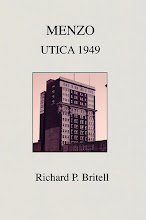This detailed drawing is done from my memory of being lost in the South Bronx. Since this happened to me more than once there are a lot of accumulated images that I have managed to fit into the drawing, not the least of which is the tire, the muffler, and the hub cap in the bottom left hand corner.
At the extreme bottom of the drawing is the Cross Bronx Expressway, and one of those exit ramps that lead up into an endless, sprawling neighborhood of tenements, crowds of people, and small businesses with foreign names. I have tried to give the drawing the feeling that the buildings go off at odd angles forever, and that there is no orderly plan to the streets so that getting lost is inevitable.
There are millions of things happening in the drawing. I could tell you about a heroin addict who is on his way to sell his girl friend’s radio, while she lies asleep on the bathroom floor. It is an old Grundig Short Wave Radio that belonged to her Grandfather. The heroin addict has made up his mind to sell it for forty dollars, but he will take twenty-five. The thought of fifteen dollars makes him really angry and he starts arguing with himself. I could tell you about a scrap metal merchant who has been buying copper futures, and has just made a huge sum of money despite himself, just because his car is stuck in traffic and his phone doesn’t work.
But I’d rather tell you about the three boys on the bridge on the left side of the drawing, under the No Left Turn Arrow. They are young hoodlums that like to hang out on the corner of the bridge. They make bets with each other about whether the cars that come up the exit ramp will click all there doors locked when they have to stop at the turn. There greatest joy is to approach the drivers window of a car that has turned left at the corner and motion for the driver to roll down the window. Then passes a long terrible moment while the driver imagines that he is about to be robbed, hijacked, or worse. Finally the driver thinks, “Well, I might as well give in to my fate, what’s the use.” He takes a heavy sigh and rolls down his window, and the boys say, “You’re going the wrong way, on a one way street, man!”
They are doing him a favor but he expects the worst. He drives away from a moment never to be forgotten, and the boys say, “Did you see his face, did you see his face,” And laugh until there sides ache.








